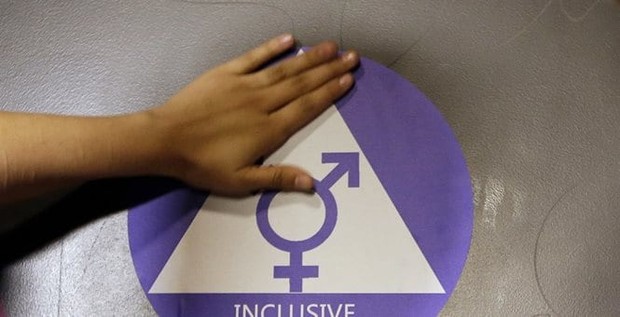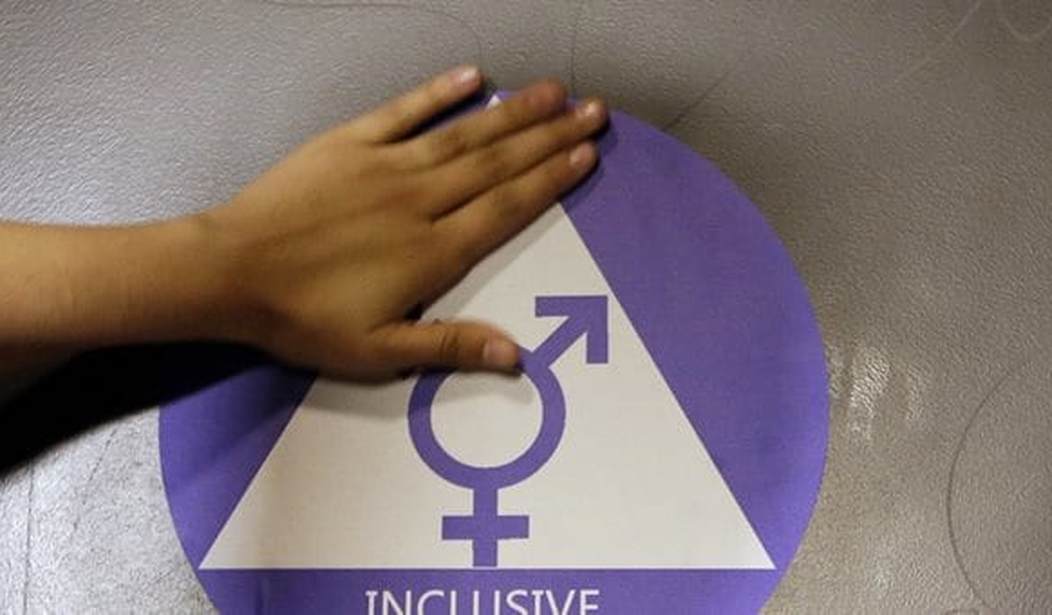
FILE – In this May 17, 2016 file photo, a new sticker is placed on the door at the ceremonial opening of a gender neutral bathroom at Nathan Hale High School in Seattle. A government official says the Trump administration will revoke guidelines that say transgender students should be allowed to use bathrooms and locker rooms matching their chosen gender identity. (AP Photo/Elaine Thompson, File)
There I was, minding my own business when an article from The Advocate came strolling into my Twitter feed. The article’s title asked a simple question.
“Is Refusing to Date Trans People Transphobic?” asked Brynn Tannehill.
Curious, I clicked on the article to read what Tannehill had to say about the matter, and what I found is exactly what I thought I would find and that was the author answering the question in the affirmative. While this is obviously ridiculous, I found it very interesting why Tannehill thought that.
To give you some context, here is the findings of the study that Tannehill drew this conclusion from:
In another study, 348 cisgender college students were shown pictures of 48 cisgender members of the opposite sex. Each picture was randomly assigned a fake biography, which included whether the person in the picture supposedly was transgender or cisgender. The college students were then asked to rate the attractiveness of the people in the pictures. The researchers found that participants were far less likely to find the people in the pictures attractive if they thought they were transgender.
The question that gets danced around, however, is: “Are all these numbers indicative of transphobia?” The answer, I believe, is clearly yes.
Tannehill goes dolling out theories as to why it’s transphobic and all of them are rather silly:
Conversely, straight men are often deathly afraid of being seen as gay because they are attracted to a transgender woman. And TERFs — trans-exclusionary radical feminists — have even conflated being set up on a blind date with a transgender person with rape and sexual assault. Though, it does call into question whether they understand what a blind date is, you don’t have to have sex on a first date, and that the owners of the coffee shop where you’re having it generally frown on that sort of thing. Conversely, some gay men are afraid that dating a transgender man would call into question their “gold-star” status.
Tannehill also tackles the idea of not wanting to be with someone who has the wrong genitalia:
Another assumption inherent in these numbers is that transgender people have the “wrong” genitals, or that they aren’t functional. While it is true that most transgender people have not had “bottom” surgery, ruling out an entire class of people based on a false assumption (that all transgender women have a penis and all transgender men have a vagina) is discriminatory.
Tannehill gives you an example of transphobia by giving you a dating scenario:
There’s mutual physical attraction and definite chemistry. Then you find out they’re transgender via conversation (yes, everyone still has their clothes on), and end the date right then and there. But for the fact that the other person was transgender, this would have been a really good date, and you probably would have seen them again. This is discrimination against the transgender person for being transgender.
There’s a lot of nonsense here and it wouldn’t irk me if this kind of thinking wasn’t so widespread, but thanks to a media that can’t seem to do anything but be a “yes man” for the LGBT community, ridiculous thinking has become acceptable to the point where common sense and reasonability has become faux pas.
Tannehill believes that the people in the study were transphobic when they swapped their answers from attractive to unattractive when they found out whether or not the person in the picture was trans. This isn’t remotely transphobic due to the fact that they’re changing their answers based on discovering the true sex of the person in the picture.
Since sex is a real, biological factor in deciding on someone’s potential as a mate for life, the sexual attractiveness can go from 60 to zero in no time flat if, say, a man finds out the person he’s interviewing as a potential partner with which to give birth to his children and raise a family with finds out that this person also has a penis and is, therefore, incapable of attracting him or giving birth.
Tannehill misunderstands this as “transphobia.” This is far from it.
If the man in our story was transphobic, then the moment he found out that the person he thought was a woman was actually a man, he would begin to exhibit fear-driven bodily reactions such as erratic movements, self-defensive postures, sweat, shaking, and irrational emotional upheaval.
A phobia is not a simple disagreement or rejection of an idea, and I feel the LGBT journalists and activists use the term “phobia” with reckless abandon as a way to sensationalize those who disagree with them.
To give you an example of what phobia really looks like, here’s a man who is so scared of dogs that he begins to cry when a puppy comes near him.
Watch as this woman attempts to overcome her crippling phobia of snakes.
These are phobias. As you can see, there is an irrational and almost uncontrollable reaction to the thing they perceive as being a massive threat to themselves, even when the object is not threatening them in any way, or even have the ability to threaten them. They’re shaking, crying, panicking, and experiencing untold amounts of self-doubt.
And just to make sure I’ve covered all my bases, the definition of “phobia” in Webster’s is “an exaggerated, usually inexplicable and illogical fear of a particular object, class of objects, or situation.”
This is not a reaction that people have to transgender people. For the subject of transphobia in dating, it’s a simple disagreement about what does and does not constitute a viable relationship. The same can be applied to gays and lesbians who are not attracted to transgender people despite the fact that they may identify as the sex necessary for a homosexual relationship to occur.
Tannehill also mentions that straight men don’t want to be “seen” as gay. This is incredibly short-sighted.
It’s not that straight men don’t want to be seen as gay, it’s that they aren’t gay. Transgender people can pretend all they want, but at the end of the day, if you’re biologically a male then you’re a male. Putting on a wig, makeup, a dress, and calling yourself “Sharon” isn’t going to change that simple, inescapable fact.
And that fact seems to make up the entirety of Tannehill’s perspective. The idea that gender is fluid is an established fact to people like Tannehill, but that’s just not reality.
You can play the “gender is not sex” game all day, but when push comes to shove there are only two genders and both of them are clearly defined with their own skeletal structures, bodily functions, chemical makeup, and brain patterns. Shouting into the ether that gender is fluid doesn’t reverse and rewrite nature.
I can say my dog is a T-Rex, but it doesn’t stop him from being a golden retriever, even if I get thousands of people to agree with me across the globe and hold a parade about it once a year. My dog will always be a dog.
In short, all the transgender journalists proclaiming transphobia on everyone who doesn’t do what they say or agree with them are disillusioned fools.















